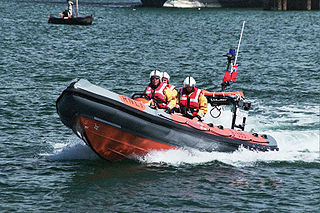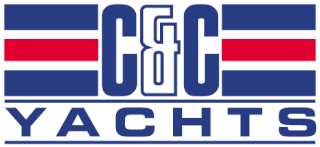
A kayak is a small, narrow watercraft which is typically propelled by means of a double-bladed paddle. The word kayak originates from the Greenlandic word qajaq.

An outboard motor is a propulsion system for boats, consisting of a self-contained unit that includes engine, gearbox and propeller or jet drive, designed to be affixed to the outside of the transom. They are the most common motorized method of propelling small watercraft. As well as providing propulsion, outboards provide steering control, as they are designed to pivot over their mountings and thus control the direction of thrust. The skeg also acts as a rudder when the engine is not running. Unlike inboard motors, outboard motors can be easily removed for storage or repairs.

A PT boat was a motor torpedo boat used by the United States Navy in World War II. It was small, fast, and inexpensive to build, valued for its maneuverability and speed but hampered at the beginning of the war by ineffective torpedoes, limited armament, and comparatively fragile construction that limited some of the variants to coastal waters. In the USN they were organized in Motor Torpedo Boat Squadrons (MTBRONs).

A dory is a small, shallow-draft boat, about 5 to 7 metres or 16 feet 5 inches to 23 feet 0 inches long. It is usually a lightweight boat with high sides, a flat bottom and sharp bows. They are easy to build because of their simple lines. For centuries, dories have been used as traditional fishing boats, both in coastal waters and in the open sea.
A folding kayak is a direct descendant of the original Inuit kayak made of animal skins stretched over frames made from wood and bones. A modern folder has a collapsible frame made of some combination of wood, aluminium and plastic, and a skin made of a tough fabric with a waterproof coating. Many have integral air chambers inside the hull, making them virtually unsinkable.

A rigid inflatable boat (RIB), also rigid-hull inflatable boat or rigid-hulled inflatable boat (RHIB), is a lightweight but high-performance and high-capacity unsinkable boat constructed with a rigid hull bottom joined to side-forming air tubes that are inflated with air to a high pressure so as to give the sides resilient rigidity along the boat’s topsides. The design is stable, light, fast and seaworthy. The inflated collar acts as a life jacket, ensuring that the vessel retains its buoyancy, even if the boat is taking on water. The RIB is an evolutionary development of the inflatable boat with a rubberized fabric bottom that is stiffened with flat boards within the collar to form the deck or floor of the boat.
The Swampscott dory is a traditional fishing boat, used during the middle of the 19th century by fishing villages along the North Shore coast of Massachusetts centered on Swampscott. It is designed to be launched off the beach. Dories were generally built by the fisherman themselves in the off season and later by more organized boatyards. The rounded hull provides more buoyancy for launching through surf than the slab sided banks dory. The flat bottom allows the boat to sit upright on the beach. The lack of a keel keeps the boat from being grabbed by a wave and allows the boat to pass cleanly through the surf. The boat still heels easily which allows large fish to be rolled into the boat vs having to lift the fish completely up over the gunnel.

The Hobie Cat is a small sailing catamaran manufactured by the Hobie Cat Company. Hobie's line of products includes surfboards, sailboats, kayaks, stand-up paddle boards, and pedalboards, although the Hobie Cat Company is known worldwide for its catamarans. Hobie also designed a successful monohull, the Hobie 33.

Sharpies are a type of hard chined sailboat with a flat bottom, extremely shallow draft, centreboards and straight, flaring sides. They are believed to have originated in the New Haven, Connecticut region of Long Island Sound, United States. They were traditional fishing boats used for oystering, and later appeared in other areas. With centerboards and shallow balanced rudders they are well suited to sailing in shallow tidal waters.

The Mutineer 15 is a 15-foot (4.6 m) long fractional sloop sailboat currently manufactured by Nickels Boat Works. It has a dinghy centerboard hull, no ballast, and displaces 410 pounds. The Mutineer 15 has a 6-foot (1.8 m) beam, maximum draw of 4.08 feet (1.24 m), and has 150 square feet (14 m2) of sail area. The Mutineer 15 is commonly used for both day sailing and class racing. The Mutineer 15 can be comfortably sailed as a day sailer with a crew of four, but can also be raced with a crew of two, or even single-handed by semi-experienced to experienced sailors.

Boston Whaler is an American boat manufacturer. It is a subsidiary of the Brunswick Boat Group, a division of the Brunswick Corporation. Boston Whalers were originally produced in Massachusetts, hence the name, but today are manufactured in Edgewater, Florida.

Hunter Marine is an American boat builder, now known as Marlow-Hunter, LLC, owned by David E. Marlow. The company also produces the Mainship powerboat brand. Marlow also owns and manufactures the Marlow Yachts brand consisting of long range power cruisers in the 37 to 110 foot range. The company is based in Alachua, Florida.

C&C Yachts was a builder of high-performance fiberglass monohull sailboats with production facilities in Canada, Germany, and the United States. C&C designed and constructed a full range of production line cruiser-racer boats, as well as custom one-off and short production run racing and cruising boats. C&C boats ranged in size from as small as 21 ft (6.4 m) to as large as 67 ft (20.4 m). C&C also produced a line of bluewater cruising boats in the 35 ft (10.7 m) to 48 ft (14.6 m) range under its Landfall brand. In addition, C&C designed sailboats for production by a number of other manufacturers such as CS Yachts, Mirage Yachts, Northern Yachts, Ontario Yachts, Paceship Yachts, and Tanzer Industries.
Fairey Marine Ltd, latterly known as FBM Marine, was a boat building company based on the River Hamble, Southampton, England. The company was created in the late 1940s by Sir Charles Richard Fairey and Fairey Aviation's managing director, Mr. Chichester-Smith. Both were avid sailing enthusiasts along with Chichester-Smith's good friend and former Olympic yachtsman, Charles Currey.

There are three designs of Phantom sailboats, one is a small una rig which is often raced, another is a lateen rig that was designed after the Sunfish model sailing dinghy, and a third is a larger keelboat designed and built in Sydney, Australia.
A rescue lifeboat is a boat rescue craft which is used to attend a vessel in distress, or its survivors, to rescue crew and passengers. It can be hand pulled, sail powered or powered by an engine. Lifeboats may be rigid, inflatable or rigid-inflatable combination hulled vessels.

The McKenzie River dory, or drift boat, is an adaptation of the open-water dory converted for use in rivers. A variant of the boat's hull is called a modified McKenzie dory or Rogue River dory. The McKenzie designs are characterized by a wide, flat bottom, flared sides, a narrow, flat bow, and a pointed stern. The sole identifying characteristic of the McKenzie River dory is a continuous rocker. It is this constant rocker that allows the boat to spin about its center for ease in maneuvering in rapids.
Wahoo! was a United States-based corporation which built fiberglass recreational boats from 1985 to 1996. Wahoo! boats were built in Hanover Industrial Park, near Ashland, Virginia.

The Minisail is a 13-foot single-handed dinghy which was designed by Ian Proctor in 1959 and became popular in the 1960s. It was the predecessor to the Topper and was the first British production boat to popularise the idea of the "sailing surfboard". As the Topper gained popularity in the 1980s, the Minisail disappeared from the scene. However, on 28 August 2011, a group of enthusiasts restarted the Minisail Class Association, which now has a small but committed following mainly in north-west Europe.













